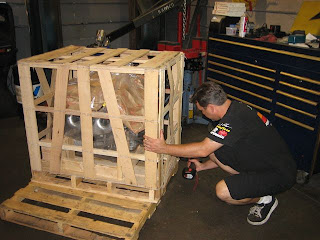The UMI system mounts right to the back of the intake manifold where the distributor would reside on an old small block engine. The cool thing about the UMI arrangement is that not only will it fire the ignition, but it's also got built-in relays for running electric fans and it will cycle them on and off according to temperature settings that you can program via a laptop. You can also create your own timing map and if you're the type that doesn't like a rough idle, this ignition system will constantly vary the timing advance to settle down the rpm variation at idle. It's a pretty trick piece!
Aside from power and ground connections everything else just plugs in. The wiring harness plugs into the coil packs.
The crankshaft reluctor wheel sensor is tapped into via this plug. You'll need to tell UMI or whoever you get an ignition system from whether you have a gray or black plug. This denotes the number of teeth on the LS engine's relutctor wheel (24x or 58x)
The cam sensor is also plugged into:
the factory temperature sending unit is located in the cylinder head on the driver's side. This is also plugged into the ignition computer.
This micro switch is bolted to the carburetor flange and sends a signal to the computer to tell it when the throttle linkage is in the idle position.
And finally, a MAP sensor is plumbed into a vacuum at the base of the Road Demon 650 cfm carburetor to tell the computer to advance the timing as the vacuum level drops, which is when the hammer is down and the butterflies are wide open!
That's pretty much it. LS engines doen't have a provision for a mechanical fuel pump (except for some cool aftermarket LS engine blocks that are out there!) so we needed a fuel system.
BG Fuel System's BG280 fuel system (http://www.barrygrant.com/) features a 280 gph electric fuel pump, an BG 2-Port Plus adjustable fuel pressure regulator, and a BG000 reusable fuel filter. We plumbed all of this into a 650cfm Road Demon carburetor.
Next time, we'll drop the engine and trans into the chassis!

















































